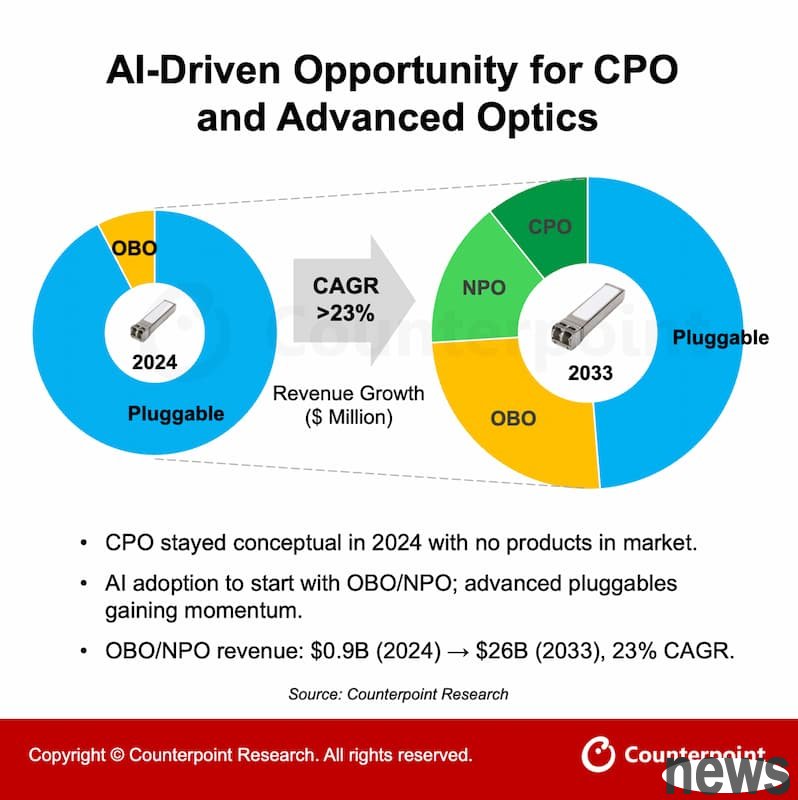
Research organization Counterpoint Research pointed out that according to this year's Semicon Taiwan Silicon Photonics International Forum, with the rapid expansion of AI servers and data center scales, traditional electrical interconnection has faced bottlenecks such as frequency width, power consumption and heat dissipation, and silicon photonic technology is becoming the pillar of next-generation computing basic facilities.
Silicon photon integrated laser, modulator, waveguide and detector are used on silicon-based wafers, and are processed compatible with CMOS, with scale-based and low-cost mass production advantages. Compared with copper wire interconnections limited by frequency width and energy efficiency, silicon photon energy has achieved 200–400 Gb/s transmission in a single scale, and is expected to break through 1 Tb/s and reduce energy consumption to <5 pJ/bit, which greatly improves the overall power consumption of the data center.
Counterpoint Research points out that without silicon photonic technology, AI data centers will encounter unbreakable power consumption and heat management bottlenecks in the next decade.
According to Counterpoint Research, AI servers have become the main driver of market growth, and are expected to account for more than 75% of overall shipments in 2028. With the promotion of large language models (LLMs), multimodal AI and cloud service providers (CSPs) high investment, silicon photonic technology will be widely used in AI clusters and super-large data centers. The overall market size is expected to approach US$6 billion in 2030, and is centered on co-packaging optics (CPO) to meet the needs of next-generation AI servers for bandwidth and efficiency.

In recent industry dynamics, Google drives the TPU v7 IronFord supercomputer through silicon photons and CPO technology, achieving 5x computing performance and 6x energy efficiency, and deploying more than 9,000 TPUs to support high-speed connections across cabinets and data centers with optical interconnections.
NVIDIA announced on GTC 2025 that the Spectrum-X "Photonics" version will be introduced into the CPO, and it is expected that small-scale production will begin in the second half of 2026. The company regards silicon photonics as the core of the "definition data center's network", and improves bandwidth density and energy efficiency through external lasers and advanced packaging, and expects to support three times the GPU size at the same power consumption.
Type has launched the COUPE 3D optical engine, which uses copper-to-copper hybrid bonding and optical-to-electric integration process, supports 224 Gbps optical interconnection, and has a standardized wavelength division multiplexing (WDM) solution, and can provide standardized PDK to accelerate photonic chip design and production.
AMD actively introduces CPO in the latest MI350/355 AI processors, breaking through frequency width and heat dissipation restrictions through end-to-end optical processes, and strengthening cooperation with supply chains to ensure scaled-up volume production.
Broadcom launched the Tomahawk 6 exchange chip in June 2025, which is the world's first 102.4 Tbps Ethernet exchange chip, and natively supports CPO technology. It also uses VCSEL NPO and CPO to double-width and low-power requirements to lock in large-scale AI networks.
Ayar Labs focuses on optical I/O grains, launching the world's first UCIe optical I/O grain, with a single grain transfer of up to 8 Tbps, and using optical wafers to achieve trans-cage AI clusters.
Brady Wang, deputy research director of Counterpoint Research, said that as demand for AI continues to rise and traditional computing is approaching the limit, silicon photonics technology is leading industry to break through to frequency, power consumption and heat dissipation bottles. From Google's AI supercomputer, NVIDIA's CPO exchanger, to TSMC's mass production platform, silicon photons are no longer just a future vision, but a core foundation of the AI era. Major manufacturers are accelerating the application and implementation of silicon photons in global data centers through innovation in design, packaging, materials and ecosystems, and promoting a new wave of computing revolution.
Extended reading: Talk about three application scenarios of AI PC! Qualcomm claims that PC is important in personal AI ecosystems Qualcomm Snapdragon 8 Elite Gen 5 scored a new high! Strong pressure Apple A19 Pro chip